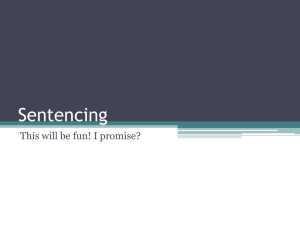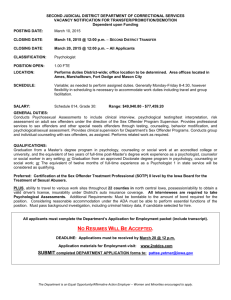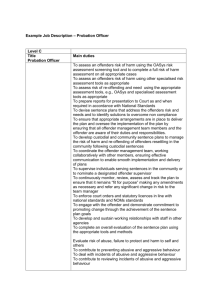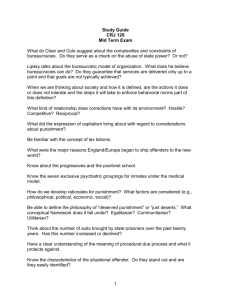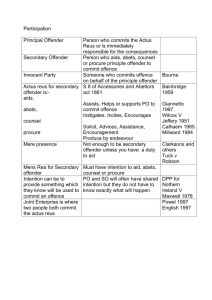File
advertisement
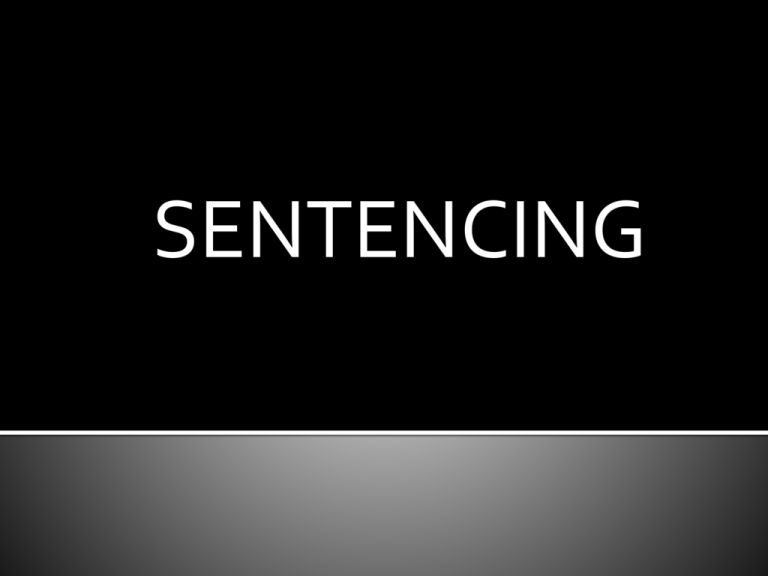
SENTENCING The fundamental purpose of sentencing is to contribute, along with crime prevention initiatives, for the respect of the law and the maintenance of a just, peaceful and safe society by imposing just sanctions that have one or more of the following objectives: a) b) c) d) e) f) To denounce the offender and other persons from committing offences; To deter the offender and other persons from committing offences; To separate offenders from society, where necessary To assist in rehabilitation offenders; To provide reparations for harm done to victims or to the community; and To promote a sense of responsibility in offenders, and acknowledgment of the harm done to victims and to the community. Mitigating Circumstances: Circumstances of the crime that lessen the responsibility of the offender. Examples??? Aggravating Circumstances: Circumstances of the crime that increase the responsibility of the offender. Examples??? Aggravating Factors Mitigating Factors Premeditation Impulsive act Previous criminal record Young or first-time offender Large profits from the offence Guilty plea Involving others in the offence Cooperation with police Ring leaders of the group Mental or physical disability Continuing offence over time Short life expectancy What do you think a judge should consider when sentencing? -Crown -Charter -Defence submission -Pre-sentence report -Accused’s criminal record -Plea bargain -Public opinion -Parole rules -Victim impact statement -Availability of resources -Pre-trial custody -guilty plea -precedents -Sentencing principles -Community -Criminal Code -Penitentiary/reformatory PRE-SENTENCE REPORT: -Probation officer investigates and writes it -Describes offenders situation -Includes interviews with offender and others who are familiar with their history (e.g. Family member) VICTIM IMPACT STATEMENT: -Statement made in court by the victim and others affected by the offence -Describes impact on their lives Once a person has been found guilty of committing a crime, the judge imposes a sentence, or punishment Sentencing has many goals: Protecting the public Retribution Deterrence Rehabilitation Restitution The main goal is to protect the public This includes: (1) protection of their person, (2) their property, and (3) their individual rights and freedoms; When a person commits an offence, that individual harms not only the victim but everyone in society; People feel threatened until the offender is apprehended and public protection is restored. When a person harms another, society often wants that person to “pay” for the offence; Retribution: punishing an offender to avenge a crime; to satisfy the public that the offender has ‘paid’ for the crime Recall: Code of Hammurabi “eye for an eye” Many believe that punishing a defender will send the message that anyone caught breaking the law will be punished accordingly; Imposing a penalty will deter (discourage) others from committing crimes; Specific deterrence: punishment as a way of discouraging criminals from reoffending; General deterrence: punishment as a way of discouraging other members of society from committing similar crimes This goal is to help offenders become law-abiding citizens; Rehabilitation: treating problems that interfere with an offender’s ability to function in society; includes services and programs : Psychiatric and medical treatment for drug and alcohol dependency, behavioural modification, etc.; Educational programs: teach offenders skills to prepare them for reintegration into the community; Recidivism: occurs when an offender returns to crime after being released from prison Thus, treatment can be matched to offender’s needs to better aid him/her in becoming more successful when reintegrated into society Restitution: requires offenders to pay society back for the injury, loss, and suffering they caused; Actual payment for damages is a more obvious form of restitution; Think ‘restore’ relationships, [i.e. restoring the relationship between offender and society (Community service)] After a defendant is convicted in a criminal trial, the sentencing process begins; For summary (minor) offences, sentencing usually takes place immediately; For indictable (major) offences, sentencing is more complex and is often delayed to allow time for the judge to make an informed decision When sentencing offenders, a judge must keep in mind the goals of sentencing: Is the offender a candidate for rehabilitation? Is the offender a threat to society? Should this offender be compelled to make restitution? To accomplish these goals, a judge has a variety of sentencing options. Sentence may be in prison (incarceration) or outside of prison (diversion programs) Defined as imprisonment for a specified length of time (each criminal offence has a maximum sentence); Length of imprisonment: Dangerous Offender: Someone who constitutes a threat to the life, safety, or physical or mental well-being of others. In such cases, s. 753(4) of the Criminal Code requires the judge impose an... Indeterminate Sentence: Where the offender is held for an indefinite period in a federal prison; offender may apply for parole. Concurrent Sentences: When criminals are convicted of more than one offence at a time, they must serve their those sentences at the same time (i.e. 2-four year sentences = 4 year prison term); Consecutive Sentences: Serve those sentences one after the other (i.e. 2-four year sentences = 8 years). These are rare in Canada. Prison is the toughest and most expensive penalty we have for offenders in Canada; The adult federal and provincial correctional system costs about $3 billion annually; The cost of keeping an offender in a federal penitentiary is about $95 000 per year! This compares with between $2000 and $9500 per year for community supervision for parolees; In sum: locking up offenders is an expensive proposition... According to the graph beside, Canada houses approximately 116 prisoners per 100,000 people Although Canada’s incarceration rate is less than a quarter of the USA, it is still higher than many European countries; There is no real evidence to suggest that locking people up has a deterrent effect, that it reduces crime, or that it even reduces the rate of recidivism; Canada has adopted an approach that gets (1) ‘tough’ with violent, high risk offenders , and (2) finds alternatives to incarcerate nonviolent, low-risk offenders. People in the provincial correctional system are either awaiting trial or serving sentences of LESS than TWO years; THREE types of custody; Facilities in this system have various levels of security: Closed Custody Protective Custody Open Custody Secured facility Separation from others in the prison Less secure facility (i.e. a halfway house) Dangerous offenders or flight risks Prisoners requiring psychological care or protection from other prisoners Non-violent offenders who are not flight risks Federal institutions are classified as maximum, medium, and minimum security; For sentences GREATER than TWO years; Prisoners in maximum security who prove themselves over time can be transferred from a maximum-security to medium-security prison MAXIMUM Security Institutions MEDIUM Security Institutions MINIMUM Security Institutions Secured with high walls, razor-wire fences, and bars on all windows and doors Fewer physical barriers No external physical barriers Armed correctional officers Fewer correctional officers Unarmed correctional officers Dangerous offenders Prisoners have more freedom and more contact with each other Employment and educational programs to assist in the transition back to society The Correctional Service of Canada (CSC) is responsible for the care and well-being of inmates in federal penitentiaries; In addition to providing food, clothing, housing and health care, CSC helps people deal with issues relating to their criminal behaviour; CSC’s goal is to contribute to public safety by reducing the chances of prisoners’ reoffending upon release; Every prisoner has a correctional plan that outlines his/her needs and priorities; the plan and progress of the individual are reviewed regularly to determine whether goals are being met and monitor the level of risk the offender poses; CSC offers programs in the following areas: Life skills Cognitive skills training Substance abuse intervention Sex offender treatment Family violence intervention Literacy Work experience


